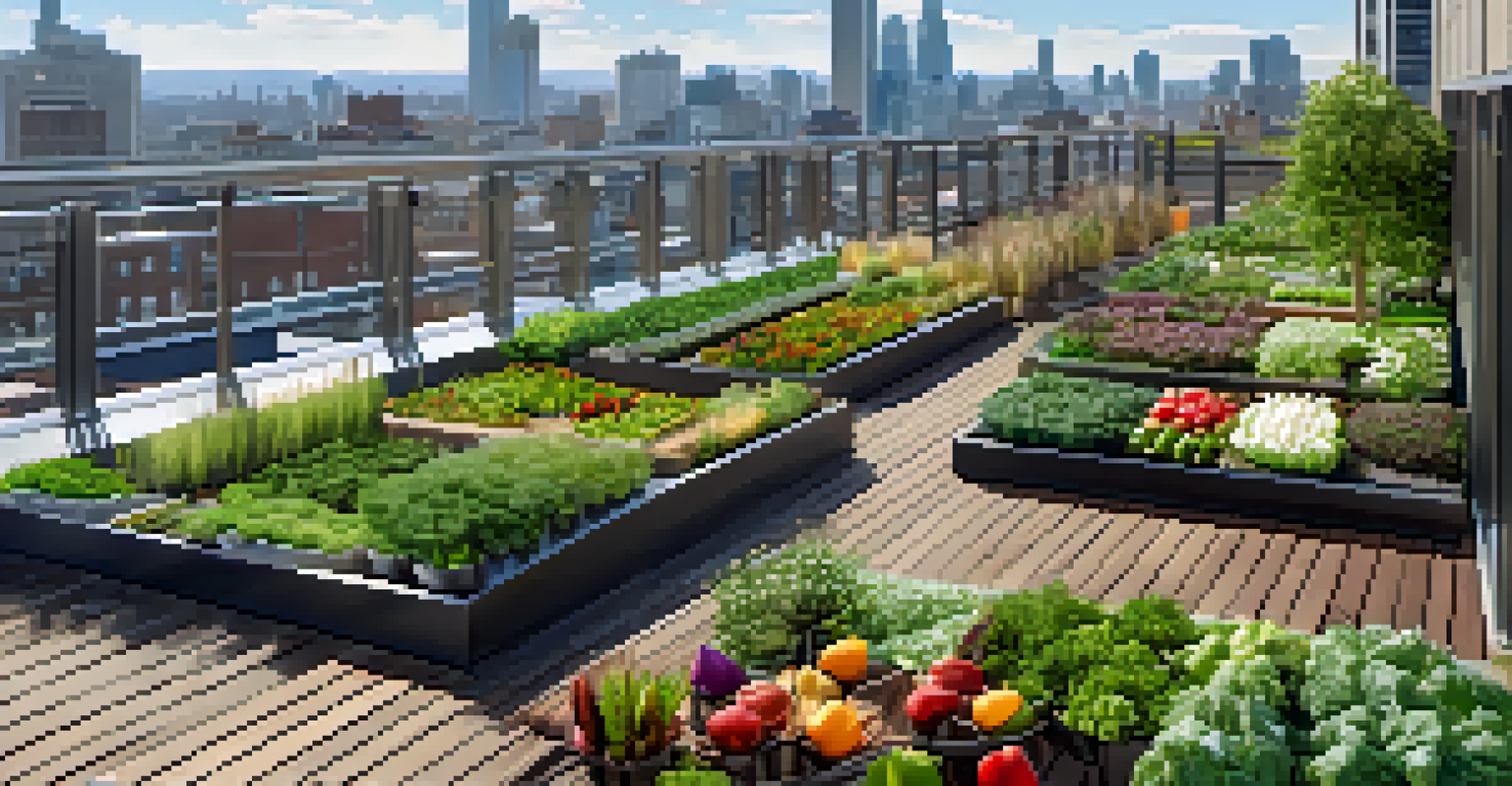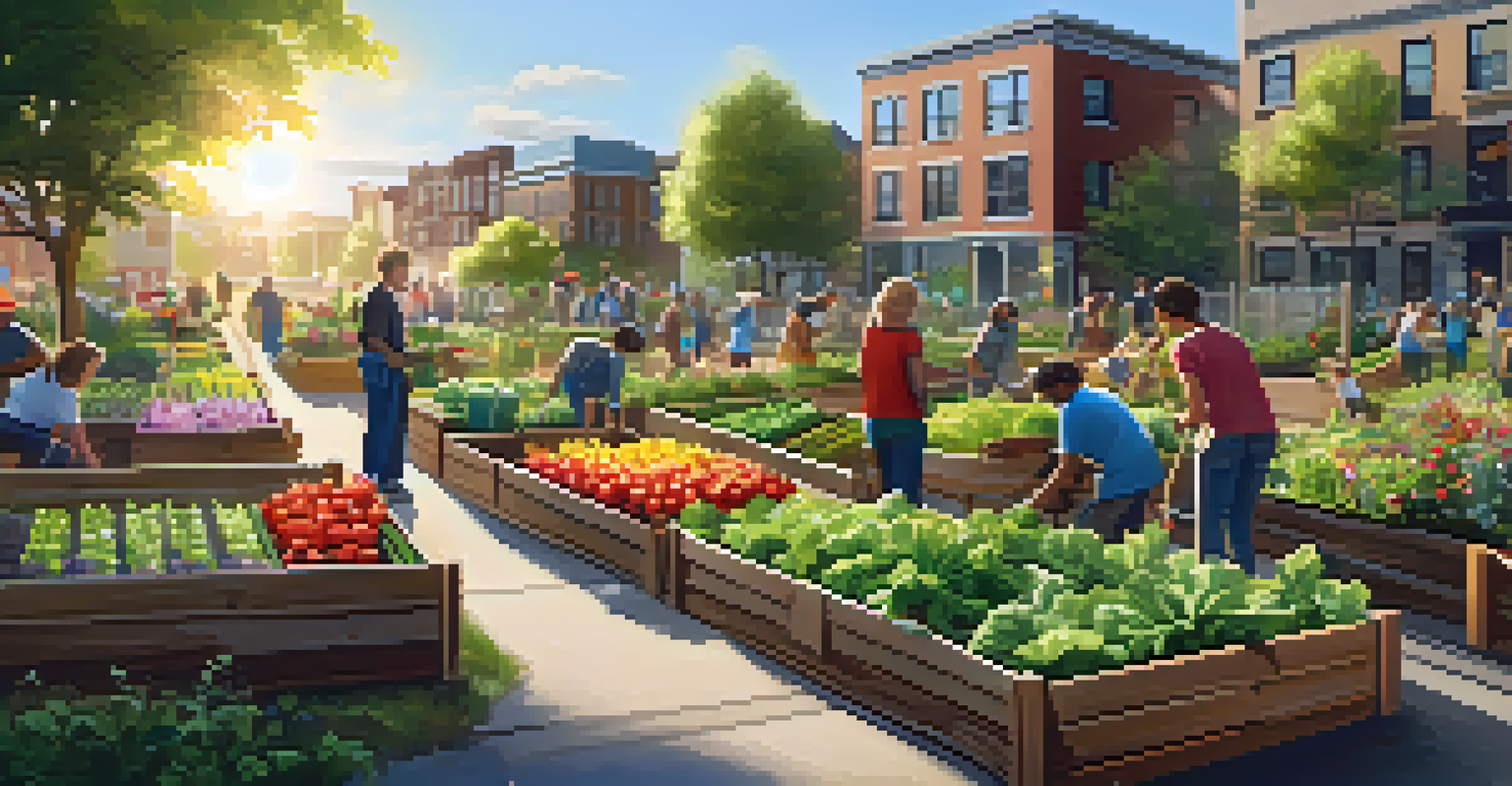The Impact of Greenery on Urban Landscape Design Trends

The Role of Greenery in Urban Design
Greenery plays a crucial role in urban design, serving as a bridge between nature and city life. It helps soften the hard edges of concrete structures, creating a more harmonious environment for residents. By integrating parks, trees, and green roofs, urban landscapes become not only more aesthetically pleasing but also more functional.
The best way to predict the future is to create it.
Adding greenery to urban areas can significantly improve air quality and reduce urban heat. For example, trees absorb carbon dioxide and release oxygen, making cities healthier places to live. Furthermore, plants can help cool down surrounding areas, making a noticeable difference during hot summer months.
Beyond environmental benefits, greenery fosters community well-being. Parks and green spaces encourage social interactions and physical activities, promoting a sense of belonging among residents. This connection to nature and community is becoming increasingly important in our fast-paced urban lives.
Sustainable Urban Design: A Growing Trend
Sustainable urban design is gaining traction as cities recognize the importance of eco-friendly practices. Incorporating greenery into urban planning not only enhances aesthetics but also contributes to sustainability goals. This trend reflects a broader commitment to reducing the environmental impact of urbanization.

Green roofs and living walls are innovative examples of how cities are integrating nature into existing structures. These features not only improve building performance but also create an inviting atmosphere in urban environments. They help mitigate stormwater runoff and insulate buildings, leading to lower energy costs.
Greenery Enhances Urban Life
Integrating parks and plants into urban areas improves aesthetics, air quality, and community well-being.
Moreover, sustainable urban design prioritizes biodiversity, encouraging the planting of native species. This not only supports local wildlife but also creates resilient ecosystems within urban settings. As more cities adopt these practices, the landscape of urban areas is transforming into greener, more sustainable spaces.
Biophilic Design: Connecting People with Nature
Biophilic design is all about creating spaces that foster a connection to nature. This concept is becoming increasingly popular in urban landscape design, as researchers highlight the mental and physical health benefits of nature exposure. From improved mood to increased productivity, the advantages of biophilic design are hard to ignore.
Nature does not hurry, yet everything is accomplished.
Incorporating natural elements such as water features, plants, and natural light into urban spaces can drastically enhance the quality of life. For instance, cities are designing parks that not only serve as recreational areas but also as peaceful retreats from the urban hustle. These spaces invite people to slow down and enjoy their surroundings.
As urban areas continue to grow, integrating biophilic principles will be essential in preserving the well-being of residents. By emphasizing natural elements in design, cities can create environments that nurture both people and nature. This approach not only enhances the urban experience but also sets a precedent for future developments.
Urban Agriculture: A Trend on the Rise
Urban agriculture is reshaping how we think about green spaces in cities. Community gardens and rooftop farms are popping up in urban areas, providing fresh produce while also promoting sustainability. This trend not only addresses food insecurity but also fosters community engagement and education around healthy eating.
These green spaces serve as a platform for social interaction and environmental stewardship. Urban agriculture encourages residents to connect with their food sources and develop a deeper appreciation for nature. In many cases, these initiatives have transformed neglected areas into vibrant community hubs.
Sustainable Design is Essential
Sustainable urban design practices, such as green roofs and native planting, are crucial for reducing environmental impacts.
Moreover, urban agriculture contributes to biodiversity and ecological health within cities. By incorporating a variety of plants and promoting pollinator habitats, urban farms enhance local ecosystems. This movement reflects a growing awareness of the interconnectedness of food systems, health, and the environment.
The Benefits of Green Infrastructure
Green infrastructure is an innovative approach to managing stormwater and enhancing urban resilience. Incorporating elements like rain gardens and permeable pavements allows cities to reduce flooding and improve water quality. This method not only addresses environmental challenges but also adds beauty to urban landscapes.
Additionally, green infrastructure promotes biodiversity by providing habitats for various species. By integrating these features into urban design, cities can create ecosystems rather than mere concrete jungles. This approach enriches the urban experience and fosters a greater appreciation for nature.
Investing in green infrastructure also yields economic benefits. Studies have shown that green spaces can increase property values and attract businesses. As urban areas become more appealing and functional, they draw in residents and tourists alike, contributing to a vibrant urban economy.
Community Engagement in Urban Greenery Projects
Community engagement is vital to the success of urban greenery projects. Involving residents in the planning process ensures that green spaces meet the needs and desires of the community. This collaborative approach fosters a sense of ownership and pride, making people more likely to care for these spaces.
Workshops, volunteer days, and local partnerships can help facilitate community involvement. For instance, residents might participate in planting trees or designing community gardens, creating lasting connections with their environment. These activities not only beautify urban areas but also strengthen community bonds.
Community Involvement is Key
Engaging residents in urban greenery projects fosters pride and ensures that green spaces meet community needs.
Moreover, engaged communities are more likely to advocate for green initiatives and support local policies. This grassroots involvement can lead to more sustainable and resilient urban landscapes that reflect the values of those who inhabit them. Ultimately, community engagement is key to creating meaningful and lasting green spaces.
Future Trends: Embracing Greenery in Urban Design
As urban areas continue to evolve, the integration of greenery will play a crucial role in shaping future design trends. Cities are increasingly recognizing the importance of creating livable, sustainable environments for their residents. This shift toward greener urban landscapes reflects a broader desire for healthier, more connected communities.
Emerging technologies and innovative design practices are paving the way for exciting developments in urban greenery. For example, vertical gardens and smart irrigation systems are making it easier to incorporate nature into urban settings. These advancements not only enhance aesthetics but also improve the functionality and resilience of urban spaces.

Looking ahead, we can expect to see a greater emphasis on holistic approaches that prioritize environmental, social, and economic sustainability. As more cities embrace these principles, the impact of greenery on urban landscape design will continue to grow, transforming how we experience and interact with our urban environments.